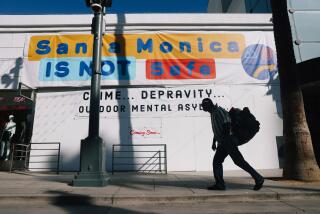Supervisors Pass Tough Law Limiting Smoking on the Job and in Public
- Share via
Seeking to protect the public from the annoyance and health hazards of secondhand smoke, the San Diego County Board of Supervisors on Tuesday approved a tough anti-smoking ordinance that severely restricts smoking in restaurants and workplaces in unincorporated areas of the county.
Hailed by Supervisor Brian Bilbray as legislative proof that “the priority in society . . . has shifted away from smokers to non-smokers,” the ordinance will require restaurants to designate at least 50% of their indoor seating capacity as a no-smoking area. Restaurants are now required to provide only enough no-smoking space to meet demand, a vague rule that allowed restaurateurs to establish their own guidelines.
Approved by a 4-1 vote, with Supervisor George Bailey dissenting, the measure also requires employers to ban smoking in shared work areas, prohibits smoking in private offices unless doors are closed and no non-smokers are present, and requires hotels and motels to provide enough non-smoking rooms to meet demand. Smoking also would be prohibited in most health facilities, waiting areas and service lines in business establishments and public areas such as restrooms.
In recognition of the fact that some businesses attract clienteles that include a large percentage of smokers, bars, lounges, bowling centers, pool halls and some other facilities were exempted from the 50% space requirement.
Economic Burden Is Cited
“We’re not trying to say people don’t have the right to smoke,” said Supervisor Leon Williams, the ordinance’s sponsor. “But they don’t have the right to hurt other people in the process. . . . As a county, we’re not trying to legislate anyone’s behavior. Our thrust here is the public’s health.”
Representatives of the restaurant and hotel industries spoke in opposition to the measure, complaining that it would be an economic burden that could cost them smokers’ business. In addition, although county workers are charged with enforcing the measure, business officials complained that practical day-to-day enforcement will be their unwelcome responsibility.
Saying that the numerical formulas and other provisions of Williams’ proposal reduce the flexibility of the current law, they concurred with Bailey’s assertion that there was “little need to change . . . an ordinance that’s working.”
But Williams and his colleagues countered by arguing that the county’s existing smoking ordinance was too general and did not go far enough to protect non-smokers’ rights--and, more importantly, their health.
Growing Medical Evidence
A lifelong non-smoker, Williams explained that his primary motivation in proposing the new ordinance was drawn from the growing medical evidence on how the inhalation of smoke can harm the health of non-smokers. Dr. David Burns, an associate professor at the UC San Diego School of Medicine, reinforced that point by testifying Tuesday that medical evidence suggests that as many as 3,000 people die annually as a result of so-called “secondhand” smoke.
“That reason alone justifies toughening the ordinance,” Williams said.
Bilbray added: “Though all of us grew up with a social environment that it was OK to light up anytime, anywhere, that perception is dying very quickly, and I think that should be reflected in law. There now is a very small percentage of people who smoke. Laws should protect the majority.”
Ordinance violators will be subject to a maximum $50 fine for a first offense, a $100 fine for a second violation and up to a $250 fine for each subsequent violation within a year.
Under the new ordinance, which is scheduled to take effect in late August, restaurants and other businesses would be required to post signs designating smoking and no-smoking areas. The San Diego office of the American Lung Assn., which strongly supported the new ordinance, has offered to make such signs available free to businesses.
Business officials, however, complained that the cost of the signs is minimal compared to the ordinance’s overall potential economic impact, warning that it could cause them to lose business among the smoking public.
“The net effect of this bill would be to probably put me in bankruptcy,” said Gerry Blowey, a small restaurant owner. “Restaurants are a very fragile business. Even 1% or 2% can make a difference.”
Harry Florentine of the San Diego Tavern and Restaurant Assn. praised the current ordinance’s flexibility in allowing restaurateurs to “self-regulate by keeping the public happy.” Now, restaurant owners can adjust the size of their smoking and no-smoking sections to meet the needs of their customers at any particular time. But the 50% space requirement, Florentine and others said, is likely to cause some space in both smoking and no-smoking areas to often go unused.
Although the supervisors disagreed with restaurateurs on that point, they conceded that the 50% requirement would be impractical for certain businesses such as bars, cocktail lounges, card rooms and pool halls that attract many smokers. Several bowling center owners, for example, told the supervisors Tuesday that more than half of their customers are smokers, adding that there is no realistic way to separate smokers from non-smokers when, as one owner put it, “You might bowl on lane 1 one week and lane 24 the next.”
“We have to recognize that certain establishments are inherently smoke-filled rooms,” Bilbray agreed.
Jails Are Exempted
The other exemptions to the ordinance include jails, stores that deal exclusively in tobacco products and accessories, hotel meeting rooms in use for private social functions, psychiatric facilities and drug clinics, and private offices assigned to a single person from which smoke cannot drift to no-smoking areas.
Although the ordinance applied only to the county’s unincorporated regions, Williams expressed the hope that it would “set an example” that will be copied by cities throughout the county.
“This is only a first step,” Bilbray concluded. “But it’s a giant one.”
More to Read
Sign up for Essential California
The most important California stories and recommendations in your inbox every morning.
You may occasionally receive promotional content from the Los Angeles Times.










